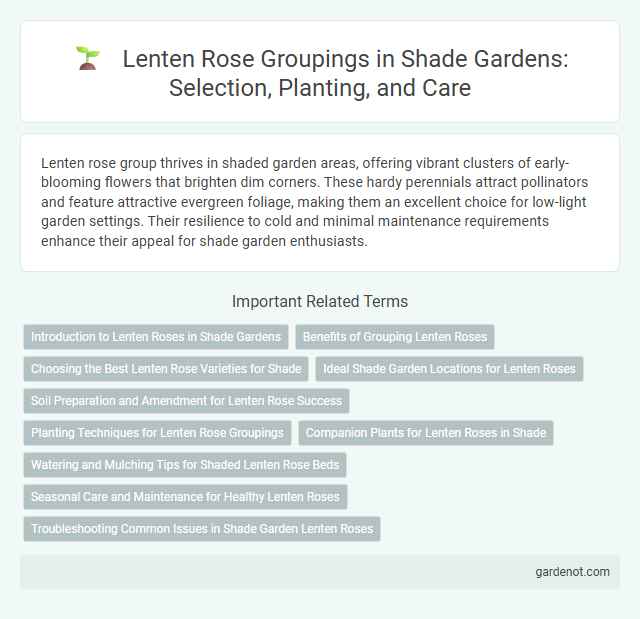Lenten rose group thrives in shaded garden areas, offering vibrant clusters of early-blooming flowers that brighten dim corners. These hardy perennials attract pollinators and feature attractive evergreen foliage, making them an excellent choice for low-light garden settings. Their resilience to cold and minimal maintenance requirements enhance their appeal for shade garden enthusiasts.
Introduction to Lenten Roses in Shade Gardens
Lenten roses (Helleborus spp.) thrive in shade gardens, offering early spring blooms that brighten dark, shaded areas. These perennials are prized for their evergreen foliage and long-lasting flowers that appear from late winter to early spring, providing crucial color when few other plants are flowering. Their deer-resistant and low-maintenance nature makes them ideal for shaded landscapes seeking year-round interest and seasonal beauty.
Benefits of Grouping Lenten Roses
Grouping Lenten roses (Helleborus orientalis) enhances their visual impact by creating dense clusters of evergreen foliage and early spring blooms, providing prolonged garden interest in shaded areas. This arrangement improves microclimate conditions, retaining moisture and reducing weed growth, which supports healthier plants with fewer maintenance needs. Clustering also fosters natural pollination and strengthens disease resistance through improved air circulation within the group.
Choosing the Best Lenten Rose Varieties for Shade
Selecting the best Lenten rose varieties for shade involves prioritizing species like Helleborus orientalis and its hybrids, which thrive in low-light conditions. Varieties such as Helleborus 'Ivory Prince' and Helleborus 'Anna's Red' offer vibrant blooms and robust growth in shaded garden areas. These plants prefer well-draining soil rich in organic matter, making them ideal for creating lush, colorful foliage beneath trees or in shaded borders.
Ideal Shade Garden Locations for Lenten Roses
Lenten roses thrive best in locations with dappled sunlight beneath deciduous trees or along north-facing garden slopes where they avoid harsh afternoon sun. Their preference for rich, well-drained, moist soil makes woodland gardens and shaded border edges ideal environments. Planting Lenten roses in these shaded, sheltered spots ensures robust growth and prolonged blooming periods in shade garden designs.
Soil Preparation and Amendment for Lenten Rose Success
Lenten roses thrive in well-draining, humus-rich soil with a pH between 6.5 and 7.0 for optimal growth and bloom. Incorporating organic matter like compost or aged leaf mold improves soil structure, moisture retention, and nutrient availability. Avoid heavy clay or waterlogged soils by amending with coarse sand or grit to enhance drainage, ensuring healthier roots and prolonged flowering periods.
Planting Techniques for Lenten Rose Groupings
Effective planting techniques for Lenten rose groupings involve choosing well-drained soil enriched with organic matter to ensure healthy root development and sustained moisture retention. Space plants approximately 18 to 24 inches apart to allow adequate air circulation, reducing the risk of fungal diseases while promoting lush, dense foliage. Position Lenten roses in partial to full shade areas, mimicking their natural woodland environment to enhance blooming and extend flowering periods.
Companion Plants for Lenten Roses in Shade
Lenten roses (Helleborus spp.) thrive in shaded gardens and pair well with ferns, hostas, and astilbes, which complement their early spring blooms and provide contrasting foliage textures. Shade-tolerant companion plants like Heuchera and Solomon's seal enhance the garden's layered look while maintaining moisture levels ideal for Lenten roses. Incorporating evergreen ground covers such as pachysandra or vinca minor helps suppress weeds and retain soil moisture, promoting healthy growth in shaded environments.
Watering and Mulching Tips for Shaded Lenten Rose Beds
Shaded Lenten rose beds require consistent moisture to thrive, with deep watering sessions once a week to keep the soil evenly moist but not soggy. Applying a 2-3 inch layer of organic mulch, such as shredded bark or leaf mold, helps retain soil moisture, regulate temperature, and suppress weeds in these low-light environments. Proper watering and mulching practices promote healthy root development and prolong the blooming period of shaded Lenten roses.
Seasonal Care and Maintenance for Healthy Lenten Roses
Lenten roses (Helleborus spp.) thrive in shaded garden areas with well-drained, humus-rich soil, requiring minimal seasonal care for optimal health. During late winter to early spring, applying a balanced, slow-release fertilizer supports robust growth and prolonged blooming periods. Regular removal of old, damaged foliage prevents disease and encourages airflow, maintaining vibrant, healthy plants throughout the growing season.
Troubleshooting Common Issues in Shade Garden Lenten Roses
Lenten roses (Helleborus spp.) in shade gardens often encounter common issues such as fungal diseases, including black spot and leaf spot, which thrive in damp, poorly ventilated conditions. To troubleshoot, ensure proper spacing for airflow, remove affected leaves promptly, and apply fungicides designed for shade-loving perennials to control outbreaks. Maintaining well-drained soil enriched with organic matter also reduces root rot risk, promoting healthier plant growth in shaded environments.
Lenten rose group Infographic

 gardenot.com
gardenot.com